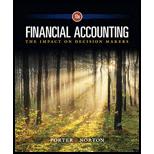
Concept explainers
1.
Recognition: is the process of formally recording an item into financial statements of a business as an asset, liability, revenue or expense. Recognition includes showing an item in both words and numbers. The purpose of financial statements is to communicate various types of economic information about a company. The job of the accountant is to decide which information should be recognized in the financial statements and how the effects of that information is on the business.
Revenue recognition is a principle which specifies conditions under which revenue is shown on the income statement for the period in which they are earned, not in the period when cash is collected.
Expense recognition specifies the condition under which expense is shown on the income statement for the period which they have incurred not in the period in which it is paid. This is on the basis of accrual accounting.
Requirement 1
The preparation of income statement for the year 1 and 2.
b
Recognition: is the process of formally recording an item into financial statements of a business as an asset, liability, revenue or expense. Recognition includes showing an item in both words and numbers. The purpose of financial statements is to communicate various types of economic information about a company. The job of the accountant is to decide which information should be recognized in the financial statements and how the effects of that information is on the business.
Revenue recognition is a principle which specifies conditions under which revenue is shown on the income statement for the period in which they are earned, not in the period when cash is collected.
Expense recognition specifies the condition under which expense is shown on the income statement for the period which they have incurred not in the period in which it is paid. This is on the basis of accrual accounting.
Requirement 2
The preparation of closing entries for each year
Want to see the full answer?
Check out a sample textbook solution
Chapter 4 Solutions
Financial Accounting: The Impact on Decision Makers
- Stark Corp is in the process of acquiring another business. In light of the acquisition, shareholders are currently re-evaluating the appropriateness of the firm's capital structure (the types of and relative levels of debt and equity). The two proposals being contemplated are detailed below: Proposal 1 Proposal 2 Estimated earnings before interest and taxes (EBIT) $ 450,000 $ 450,000 Long term debt 1,000,000 2,000,000 Market value of equity 1,000,000 500,000 Interest rate on long term debt 10% 10% Tax rate 25% 25% Required Calculate the estimated return on equity (ROE) under the two proposals. (ROE = net income after taxes / market value of equity; net income after taxes = (EBIT - interest on long-term debt) × (1 - tax rate)).arrow_forwardI need guidance with this financial accounting problem using the right financial principles.arrow_forwardAtlas corporations price earnings ratio??arrow_forward
- Please provide the accurate answer to this general accounting problem using appropriate methods.arrow_forwardThe equity method of accounting is suitable for investments representing what? (1) Less than 20% ownership (2) Between 20% and 50% ownership (3) More than 50% ownership (4) Only for foreign investments answerarrow_forwardHelp this answerarrow_forward
- Gentry Co. reported total gross sales of $320,000, with 60% of these being credit sales. Sales returns and allowances of $18,000 apply only to the credit sales. A 1.5% sales discount was taken on all net credit sales. Additionally, credit card sales amounted to $110,000 and were subject to a 2.5% credit card fee. What is the dollar amount of net sales?arrow_forwardAlicia Industries has a net income of $89,000 and total assets of 445,000. What is the return on assets? A) 18% B) 20% C) 21.2% D) 15%arrow_forwardMontu Consultants Corporation obtained a building, its surrounding land, and a computer system in a lump-sum purchase for $375,000. An appraisal set the value of the land at $184,500, the building at $144,000, and the computer system at $121,500. At what amount should Montu Consultants record each new asset on its books?arrow_forward
- accounting questionsarrow_forwardHow much are the total assets of the firm?arrow_forwardEddie Woodworks manufactures custom shelving. During the most productive month of the year, 4,200 units were manufactured at a total cost of $73,500. In the month of lowest production, the company made 1,600 units at a cost of $49,800. Using the high-low method of cost estimation, total fixed costs are__. a. $22,200 b. $30,600 c. $35,208 d. $45,000arrow_forward
 Financial AccountingAccountingISBN:9781305088436Author:Carl Warren, Jim Reeve, Jonathan DuchacPublisher:Cengage Learning
Financial AccountingAccountingISBN:9781305088436Author:Carl Warren, Jim Reeve, Jonathan DuchacPublisher:Cengage Learning College Accounting (Book Only): A Career ApproachAccountingISBN:9781337280570Author:Scott, Cathy J.Publisher:South-Western College Pub
College Accounting (Book Only): A Career ApproachAccountingISBN:9781337280570Author:Scott, Cathy J.Publisher:South-Western College Pub Individual Income TaxesAccountingISBN:9780357109731Author:HoffmanPublisher:CENGAGE LEARNING - CONSIGNMENT
Individual Income TaxesAccountingISBN:9780357109731Author:HoffmanPublisher:CENGAGE LEARNING - CONSIGNMENT




